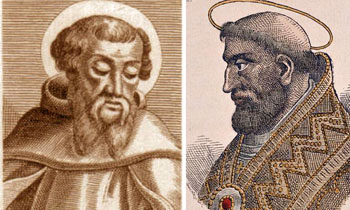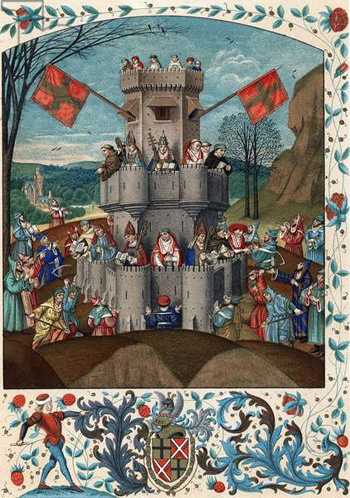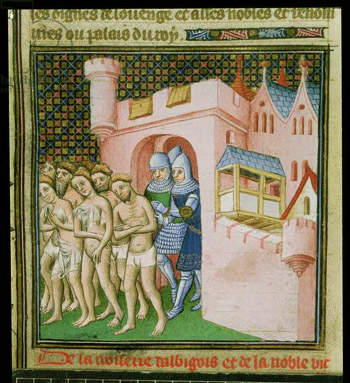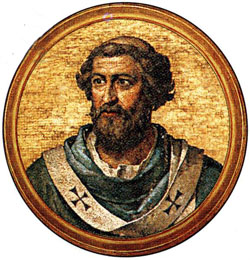Sts. Irenaeus of Lyons & Pope Leo II
Biographical selection:
Two saints are commemorated on July 3: St. Leo II, Pope and Confessor, and St. Irenaeus of Lyons, Bishop and Confessor.
Pope St. Leo approved the Acts of the 6th Ecumenical Council, which condemned the lack of zeal of one who, in the Saint's words, instead of purifying the Apostolic Church, allowed her to be defiled by a profane betrayal (7th century).
It is also the feast of St. Irenaeus of Lyons, to whom, according to the prayer of the liturgy, God gave the grace to destroy heresies to preserve the truth of the doctrine in his fight against the Gnostics in the 2nd century:

St. Irenaeus (130-202) and Pope St. Leo II (d. 683)
"Irenoeo Martyri Pontifici tribuisti, ut et veritate doctrinae expugnaret haereses, et pacem Ecclesiae feliciter confirmet."
[We pay tribute to Pontiff (Bishop) Irenaeus martyr, because he fought
against the heresies and efficiently confirmed the true doctrine and the
peace within the Church]
Comments of Prof. Plinio:
You see that they are both saints, one a Pope and the other a Bishop, who lived a great distance apart in time from one another, since St. Irenaeus lived in the 2nd century and St. Leo in the 7th century.
A great distance despite the fact that when we hear about the 2nd and 7th centuries, we – who are in the 20th century – have the impression that the 2nd and 7th centuries were not so far apart, something that seems to happen when we gaze far back in time. But in reality, we can calculate the span this represents by imagining what 500 years in the past would signify for us now.
That is to say, the chronological distance between these two centuries is more or less what exists between the discovery of Brazil and today's Brazil. One can then understand the distance in time between these two saints
Now then, despite such a distance of place, time, epoch and, above all, such a distance from us, the Liturgy elevates these two figures and places them together on July 3 for the veneration of the faithful. The two figures are raised up together, having a common trait, which is this:

The Church, Fortress of Truth, defended by the Pope, prelates, theologians
They fought against heresies, they expelled heretics from inside the
Church. According to the Liturgy, doing this, they avenged the honor of
the Church because heresy tried to stain the Church's honor, which is
immaculate. For this reason, the honor of the Church demanded the
expulsion of heretics.
It demanded that heresy be driven out, because there can be no peaceful coexistence, no normal cohabitation between good and evil, truth and error. This is never allowable, but, above all, it cannot be inside the Catholic Church, which is par excellence the sacred mountain of truth and goodness, which repels of herself, with horror, anyone who defends error and evil.
Some may protest saying: “But where is the role of mercy in this position?” Indeed, the Church has a great deal of mercy and she does not expel one who acknowledges that he is wrong, one who strikes his chest and asks forgiveness for his wrongdoing. But she does drive out one who, inside the Church, affirms that good is evil or evil is good, one who strives to spread evil inside the Church.
The Church expels such a person with horror for two reasons: first, because he causes the loss of souls inside the Church; second, for a higher reason, which is her fundamental opposition to those who spread heresy; she cannot support at her side those who do this.
This stems ultimately from the nature of the principle of contradiction. Everything that is alive, by the very fact of being alive, has a horror of what is contrary to it and with all the force of its vitality repels what is contradictory.

In the name of the Church, soldiers expel Albigensians from Carcassone Castle
And the Church, whose life is eternal, perennial and supernatural has a
constant horror of what is contrary to her. Thus, it is in her very
nature to eject from herself heretics, to throw out what is the evil
spirit itself.
If she shows herself as sluggish, lazy or slow in rebuking evil, this means that her children or her representatives who take this position have a Faith that is in a state of decline, in the state of a waning sun. When the Faith is in a state of dawn or full noon, it does not compromise. When Faith declines, it begins to grow old, to shrivel and afterwards become stagnant and decompose. Then, it no longer feels this fundamental incompatibility with that which is contrary to it.
So, we understand why the Church insists on the liturgy – what was quoted to you are excerpts from the Liturgy – when, on a feast of the Saint, she sings the glory of the Saint: she calls him Pontiff as a title of glory of the Bishop-Saint who has ejected evil from the Church.
The Church says of Pope St. Leo II: "He had the grace to expunge from the Church a man who tainted the Immaculate Church." What is the reason for this? Clearly it is because the Church wants to show in the clearest way possible that the virtue and authenticity of the Faith are opposed to the compromise that is so often seen today.

Honorius, a Pope condemned for his heresy
These words of the liturgy relate to the life of St. Leo II. This Pontiff approved the minutes of the 6th
Ecumenical Council, which condemned the lack of zeal of one who, in his
words, instead of purifying this Apostolic Church, allowed the
Immaculate One to be defiled by a profane betrayal.
Who was the one about whom Pope Leo II was speaking? It was Pope Honorius. Pope St. Leo II in fact said this about his predecessor Honorius.
He had this tremendous hardship of living in the time of a Pope who was condemned by a Pope at a Council that took place after his death. You understand the very difficult days in which Saint Leo II lived.
Read more about the condemnation of Pope Honorius by Pope Leo II here.
Two saints are commemorated on July 3: St. Leo II, Pope and Confessor, and St. Irenaeus of Lyons, Bishop and Confessor.
Pope St. Leo approved the Acts of the 6th Ecumenical Council, which condemned the lack of zeal of one who, in the Saint's words, instead of purifying the Apostolic Church, allowed her to be defiled by a profane betrayal (7th century).
It is also the feast of St. Irenaeus of Lyons, to whom, according to the prayer of the liturgy, God gave the grace to destroy heresies to preserve the truth of the doctrine in his fight against the Gnostics in the 2nd century:

St. Irenaeus (130-202) and Pope St. Leo II (d. 683)
Comments of Prof. Plinio:
You see that they are both saints, one a Pope and the other a Bishop, who lived a great distance apart in time from one another, since St. Irenaeus lived in the 2nd century and St. Leo in the 7th century.
A great distance despite the fact that when we hear about the 2nd and 7th centuries, we – who are in the 20th century – have the impression that the 2nd and 7th centuries were not so far apart, something that seems to happen when we gaze far back in time. But in reality, we can calculate the span this represents by imagining what 500 years in the past would signify for us now.
That is to say, the chronological distance between these two centuries is more or less what exists between the discovery of Brazil and today's Brazil. One can then understand the distance in time between these two saints
Now then, despite such a distance of place, time, epoch and, above all, such a distance from us, the Liturgy elevates these two figures and places them together on July 3 for the veneration of the faithful. The two figures are raised up together, having a common trait, which is this:

The Church, Fortress of Truth, defended by the Pope, prelates, theologians
It demanded that heresy be driven out, because there can be no peaceful coexistence, no normal cohabitation between good and evil, truth and error. This is never allowable, but, above all, it cannot be inside the Catholic Church, which is par excellence the sacred mountain of truth and goodness, which repels of herself, with horror, anyone who defends error and evil.
Some may protest saying: “But where is the role of mercy in this position?” Indeed, the Church has a great deal of mercy and she does not expel one who acknowledges that he is wrong, one who strikes his chest and asks forgiveness for his wrongdoing. But she does drive out one who, inside the Church, affirms that good is evil or evil is good, one who strives to spread evil inside the Church.
The Church expels such a person with horror for two reasons: first, because he causes the loss of souls inside the Church; second, for a higher reason, which is her fundamental opposition to those who spread heresy; she cannot support at her side those who do this.
This stems ultimately from the nature of the principle of contradiction. Everything that is alive, by the very fact of being alive, has a horror of what is contrary to it and with all the force of its vitality repels what is contradictory.

In the name of the Church, soldiers expel Albigensians from Carcassone Castle
If she shows herself as sluggish, lazy or slow in rebuking evil, this means that her children or her representatives who take this position have a Faith that is in a state of decline, in the state of a waning sun. When the Faith is in a state of dawn or full noon, it does not compromise. When Faith declines, it begins to grow old, to shrivel and afterwards become stagnant and decompose. Then, it no longer feels this fundamental incompatibility with that which is contrary to it.
So, we understand why the Church insists on the liturgy – what was quoted to you are excerpts from the Liturgy – when, on a feast of the Saint, she sings the glory of the Saint: she calls him Pontiff as a title of glory of the Bishop-Saint who has ejected evil from the Church.
The Church says of Pope St. Leo II: "He had the grace to expunge from the Church a man who tainted the Immaculate Church." What is the reason for this? Clearly it is because the Church wants to show in the clearest way possible that the virtue and authenticity of the Faith are opposed to the compromise that is so often seen today.

Honorius, a Pope condemned for his heresy
Who was the one about whom Pope Leo II was speaking? It was Pope Honorius. Pope St. Leo II in fact said this about his predecessor Honorius.
He had this tremendous hardship of living in the time of a Pope who was condemned by a Pope at a Council that took place after his death. You understand the very difficult days in which Saint Leo II lived.
Read more about the condemnation of Pope Honorius by Pope Leo II here.
